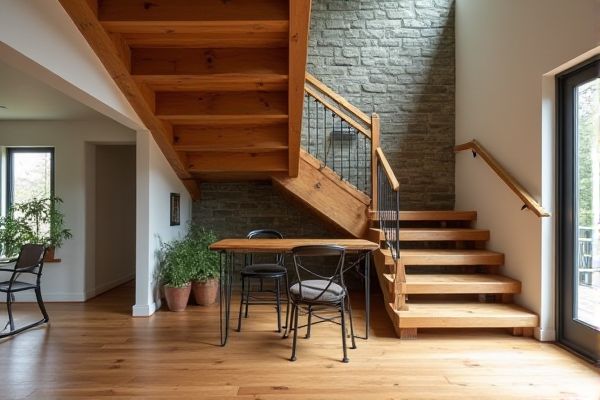
Reclaimed wood staircases offer unique character, sustainability, and often lower environmental impact compared to new wood staircases, which provide uniformity, specific wood species options, and modern treatments for durability. Explore this article to discover which staircase choice best suits your style, budget, and environmental values.
Table of Comparison
| Feature | Reclaimed Wood Staircase | New Wood Staircase |
|---|---|---|
| Material Source | Recycled old wood from barns, factories, or homes | Freshly harvested and milled lumber |
| Environmental Impact | Eco-friendly, reduces deforestation and waste | Higher environmental footprint due to logging |
| Cost | Moderate to high, depends on wood quality and sourcing | Generally lower, depending on type of wood |
| Durability | High durability, often from dense, aged hardwoods | Varies by wood species; can be less dense |
| Appearance | Unique character with natural patina and imperfections | Consistent, clean finish with uniform grain |
| Installation Complexity | Potentially complex due to variable wood sizes and shapes | Simpler installation with standardized lumber |
| Maintenance | May require occasional refinishing to preserve look | Standard maintenance, easier to refinish |
| Value Addition | High aesthetic and eco value, adds character to home | Modern look, less unique but flexible design options |
Introduction to Reclaimed vs New Wood Staircases
Reclaimed wood staircases offer unique character, durability, and eco-friendliness by repurposing aged timber with rich textures and history, while new wood staircases provide uniformity, modern standards, and a wider range of design options. Choosing reclaimed wood supports sustainable building practices and can add authentic charm to your home, whereas new wood ensures consistency and easier customization. Your decision depends on desired aesthetics, budget, and environmental considerations.
Aesthetic Appeal and Design Options
Reclaimed wood staircases offer a unique aesthetic appeal with their rich textures, weathered finishes, and historical character, creating a warm and rustic ambiance that enhances any interior design. New wood staircases provide greater design flexibility with a wide variety of species, colors, and finishes, allowing for sleek, modern, or traditional styles tailored to your exact preferences. Your choice depends on whether you prioritize the nostalgic charm of reclaimed materials or the customizable, pristine look of new wood.
Sustainability and Environmental Impact
Reclaimed wood staircases significantly reduce environmental impact by reusing existing materials, minimizing deforestation and landfill waste compared to new wood staircases that require fresh timber harvesting. The embodied carbon footprint of reclaimed wood is considerably lower, promoting sustainable building practices. Choosing reclaimed wood for your staircase supports conservation efforts and decreases the demand for virgin wood, contributing to a greener, more eco-friendly home.
Durability and Longevity
Reclaimed wood staircases often exhibit superior durability due to the dense, aged timber that has withstood decades of natural wear, making them less prone to warping and cracking compared to new wood. New wood staircases, especially those made from kiln-dried lumber, offer consistent quality and resistance but may require more maintenance to ensure longevity. Factors like species type, treatment processes, and environmental conditions significantly influence the lifespan of both reclaimed and new wood staircases.
Cost Comparison and Budget Considerations
Reclaimed wood staircases often cost less upfront due to the reuse of existing materials, with prices ranging from $50 to $150 per step depending on wood quality and sourcing, while new wood staircases typically cost between $100 and $250 per step. Budget considerations should include potential additional expenses for reclaimed wood, such as extra labor for cleaning and refinishing, which can increase total costs despite lower material prices. Your choice depends on balancing initial cost savings against labor intensity and desired aesthetic, with reclaimed wood offering unique character and sustainability benefits without necessarily inflating your budget.
Installation Process and Challenges
Reclaimed wood staircases require careful inspection for structural integrity and may involve extensive prep work like cleaning, sanding, and treating to ensure safety and durability. New wood staircases typically offer a more streamlined installation process with consistent material quality and fewer unexpected defects, allowing for faster completion. Your choice impacts installation time and complexity, with reclaimed wood demanding skilled craftsmanship to address potential warping, nails, or holes.
Maintenance and Care Requirements
Reclaimed wood staircases require specialized maintenance to address potential issues like warping, cracks, and old nail holes, often needing periodic sealing and careful cleaning to preserve their character. New wood staircases typically benefit from modern treatments and finishes that make them more resistant to moisture, scratches, and wear, reducing overall upkeep demands. Your choice will impact the frequency and type of care necessary to maintain the staircase's appearance and structural integrity over time.
Sourcing and Availability
Reclaimed wood staircases offer unique character through salvaged timber sourced from old barns, factories, and warehouses, providing an eco-friendly alternative by reducing demand for new lumber and preserving historic materials. Availability of reclaimed wood depends heavily on regional deconstruction projects and the condition of salvaged wood, often requiring specialists for proper selection and treatment. In contrast, new wood staircases rely on sustainably managed forests with more consistent supply chains, allowing for standardized sizing and quicker procurement but lacking the distinct aged appearance of reclaimed wood.
Potential for Customization
Reclaimed wood staircases offer unparalleled potential for customization due to the unique character and varied textures of salvaged timber, allowing artisans to create distinctive, one-of-a-kind designs. New wood staircases provide greater flexibility in size, shape, and finish options, enabling precise tailoring to contemporary architectural styles and specifications. Combining reclaimed wood with modern carpentry techniques can further enhance customization, blending rustic charm with structural innovation.
Value Addition to Property
Reclaimed wood staircases enhance property value by offering unique character, sustainability, and aged craftsmanship that appeals to eco-conscious buyers and those seeking authentic materials. New wood staircases provide a modern, uniform appearance with the flexibility to choose specific wood types and finishes, increasing appeal for contemporary designs. Properties with reclaimed wood often command higher market prices due to their distinct aesthetic and environmental benefits.
 homyna.com
homyna.com